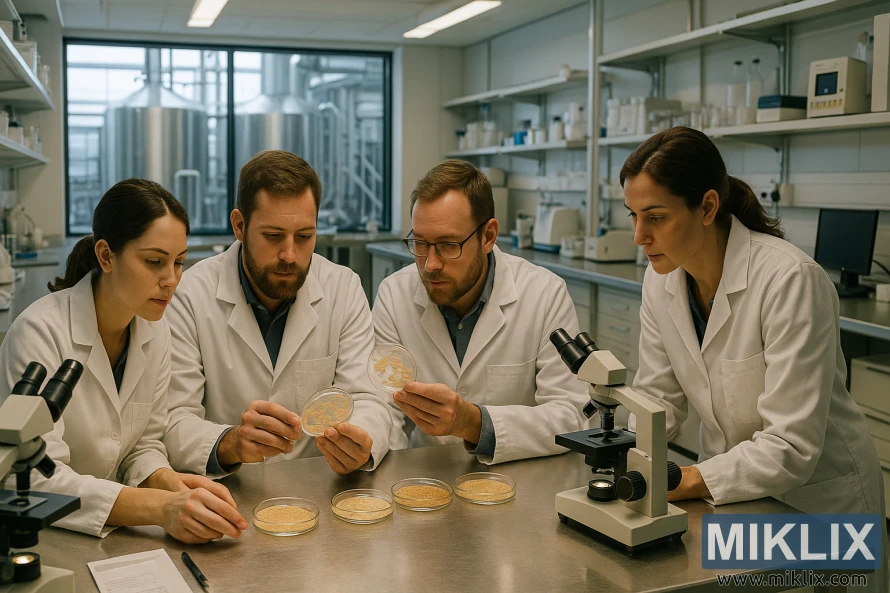Image: Lab Inspecting Yeast for Brewing Quality Control
Published: July 21, 2025 at 2:53:22 PM UTC
Last updated: September 27, 2025 at 9:26:09 PM UTC
Well-lit lab with microbiologists studying yeast colonies, surrounded by instruments, ensuring LalBrew Nottingham yeast quality.
This image captures a moment of focused collaboration in a professional laboratory where microbiology meets the art of brewing. Four individuals, dressed in crisp white lab coats and seated around a central worktable, are deeply engaged in examining a series of petri dishes. Their body language and expressions suggest a shared sense of purpose, as they scrutinize the growth patterns, textures, and coloration of microbial colonies—likely yeast strains under evaluation for fermentation performance. The petri dishes, arranged methodically across the table, serve as miniature landscapes of biological activity, each one offering clues about viability, purity, and metabolic behavior.
The lighting in the room is bright and clinical, pouring down from overhead fixtures and illuminating every surface with clarity. This even illumination ensures that no detail is missed, whether it’s the subtle morphology of a yeast colony or the fine print on a reagent label. The stainless steel benches and shelving units reflect the light, adding a sense of sterility and order to the space. These surfaces are populated with an array of scientific tools: compound microscopes poised for close inspection, pipettes ready for precise transfers, and analytical instruments that hint at deeper biochemical testing. The layout is both functional and efficient, designed to support rigorous experimentation and real-time decision-making.
In the background, the laboratory opens up to a larger industrial space visible through a wide window. Here, the brewing process unfolds on a grander scale, with towering stainless steel tanks, insulated piping, and control panels forming a complex network of production. This juxtaposition between the micro and macro—the petri dish and the fermentation tank—underscores the interconnectedness of lab work and brewing. What begins as a microscopic observation in the lab ultimately influences the flavor, clarity, and stability of the beer produced in the adjacent facility.
The shelves lining the walls are stocked with bottles, binders, and containers, each meticulously labeled and organized. These materials suggest a culture of documentation and traceability, where every strain, sample, and result is recorded and archived. It’s a space that values both innovation and accountability, where scientific inquiry is not just about discovery but about maintaining standards and ensuring reproducibility. The presence of multiple researchers working together reinforces the collaborative nature of the endeavor. Their shared focus on the petri dishes suggests a team effort—perhaps a routine quality control check, a comparative study of yeast strains, or an investigation into a fermentation anomaly.
Overall, the image conveys a sense of precision and dedication. It’s a portrait of a laboratory that serves as the nerve center of a brewery, where the invisible agents of fermentation are studied, understood, and optimized. The atmosphere is one of quiet intensity, where every observation matters and every decision carries weight. Through its composition and detail, the image invites the viewer to appreciate the scientific backbone of brewing—the meticulous work that ensures each batch of beer meets the highest standards of quality and character. It’s a celebration of the unseen labor behind the craft, where microbiology and brewing expertise come together in pursuit of excellence.
The image is related to: Fermenting Beer with Lallemand LalBrew Nottingham Yeast

